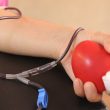The study included 36292 consecutive patients undergoing acute myocardial infarction receiving PCI with the new generation stent SYNERGY (thin struts, bioresorbable polymer and everolimus eluting); 39.7% presented ST elevation MI. Kaplan-Meier curves at 2 years of patients receiving the SYNERGY vs patients receiving other drug eluting stents resulted very similar for thrombosis (0,69% vs 0,81%,...
ACC 2018 | SECURE-PCI: High Dose of Statins pior PCI Could Help
Patients undergoing acute coronary syndrome (ACS) loaded with a high dose of statins prior diagnostic catheterization do not seem to benefit from this strategy. However, when looking at those undergoing PCI alone (excluding all patients who had received surgery or medical treatment), the benefit appears as a reduction of combined major events. The benefit of atorvastatin loading...
The Use of Intravascular Imaging to Guide PCI Reduces Cardiovascular Death Risk, Compared to Angiography
Intravascular imaging, which includes ultrasound intravascular (IVUS) and optical coherence tomography (OCT), shows live details that better characterize post stenting plaque, anatomy and outcomes. The already familiar limitations of the angiography has lead us to think that IVUS and OCT could improve clinical outcomes; however, we should still find the evidence to support this claim. To shed some...
Complex PCI: DAPT defining factor?
Courtesy of Dr. Alejandro Lakowsky, MTSAC. The Journal of the American College of Cardiology (JACC) has recently published a study on the role of coronary anatomy and PCI technical difficulty in the cost benefit ratio of prolonged vs. short post procedural DAPT. This study was carried out by Robert Yeh, Laura Mauri and the DAPT trial...
Though on the Rise, the Transradial Approach to Primary PCI Remains Underused
There is evidence to support the use of the transradial approach to coronary angioplasty. Several randomized studies have shown reduced bleeding and vascular complications when adopted, compared against patients treated with the femoral approach. There are also studies and meta-analysis suggesting that, in the context of primary PCI, the benefit would be even bigger, with significant events...
The End of Aspirin for Anticoagulated Patients Undergoing PCI
The discussion about the best anti-thrombotic strategy for patients with atrial fibrillation undergoing PCI seemed never-ending until the RE-DUAL PCI trial was published in the New England Journal of Medicine (NEJM). This study has arrived to simplify the tough choice between the risk of a thrombotic event vs. the risk of bleeding with a simpler scheme, without...
EXCEL-QOL Substudy: Similar Quality of Life both with CABG and Left Main PCI
Courtesy of SBHCI. According to a new quality of life sub-study, the “EXCEL”, both coronary artery bypass graft and left main PCI are associated with significant clinical improvement in terms of angina frequency, tolerance to exertion and treatment satisfaction. At 12 and 36 months, there were no significant differences between PCI and surgery after several quality of...
Impella Improves Safety in High Risk Unprotected Left Main PCI
Courtesy of Dr. Carlos Fava. The incidence of unprotected left main severe stenosis ranges between 4 and 8%, and it’s mostly associated with multivessel disease. The use of left ventricular support devices in high risk unprotected left main PCI is on the rise, but not much information available in this regard. Read also: “Prior assistance...
Introducing the number one enemy of PCI: diabetes
About 25% of patients with multivessel disease undergoing myocardial revascularization surgery or PCI have diabetes. In this subgroup, the benefit of surgery in terms of mortality has long been shown: in the BARI study (Bypass Angioplasty Revascularization Investigation) patients undergoing PCI had close to double the mortality rate at 5 years compared to those...
“Ad Hoc” PCI during TAVR: No Impact on Safety or Long Term Outcomes
According to a recent study published in Circulation Cardiovascular Interventions, screening for coronary artery disease (CAD) with an invasive coronary angiography (as part of the protocol prior TAVR) and performing PCI and TAVR in the same session, has no impact on periprocedural safety or on long term outcomes. Study outcomes offer new hope, especially as regards using TAVR...









